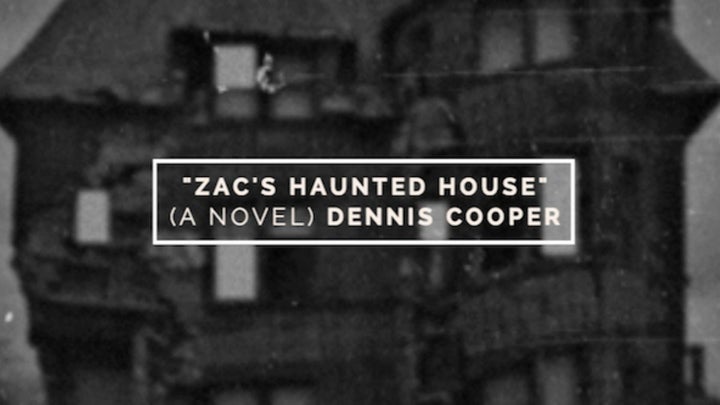Set a copy of Pride and Prejudice next to this:
Could any two forms seem more distinctly unlike than a novel and a GIF? But in the eyes of Dennis Cooper, the prolific artist and writer behind Zac’s Haunted House, they’re not so distantly related.
Zac’s Haunted House, recently published by Kiddiepunk, is presented as a novel -- it's five chapters, plus a preface and afterward, and it's subtitled "A Novel" -- but if you're looking for prose, you'll have to keep looking. The piece is entirely constructed of curated GIFs, presented in a simple vertical column, aside from the headings denoting "Chapter One," "Chapter Two," and so on.
Critics have, by and large, taken this subtitle at face value, despite Cooper’s work bearing no tangible resemblance to a novel. Can something be described as fiction if it has no narrative? Do five chapters, each containing around 50 GIFs, together comprise a “book-length” work? What if the medium not only isn’t prose writing, but isn’t writing at all? Seriously, there are no words in the narrative of Zac's Haunted House.
The novel may be the most abused genre in literature. For generations, we’ve been ignoring the true criteria of the novel in order to use the term as a catchall for romances, narrative nonfiction, drama and epic poems. Originally, a novel referred to a book-length narrative of prose fiction exploring the world in realistic, believable ways. In recent years, we've narrowed it down to a book-length fictional narrative in prose, though even this definition is sometimes stretched, and threatened with obsolescence.
In 2014, Ben Yagoda took to Slate to ask, “Does novel now mean any book?”
He wrote:
I was taken aback recently to pick up an (unnamed) magazine for which I'd written an article and see my brief bio begin with the words: "Ben Yagoda is a novelist. … " I am not a novelist, never have been [...] I came to understand that the person who wrote the bio wasn't misinformed or making stuff up, but rather took "novelist" to mean the same as "author," or, more specifically, "writer of books," and maybe even more specifically than that, "writer of more or less meritorious books."
Yagoda blames graphic novels, a term that continued to envelope all graphic narratives even after memoir and other nonfictional forms entered the mix. (Technically, Fun Home is a graphic memoir, not a graphic novel.) Putting blame aside, however, what’s with this rush to slap “novel” on every conceivable form of non-novel art or writing?
In Cooper’s case, there’s a pretty solid genre already suited to his GIF sequence: video art. In fact, even GIF art, more specifically, is nothing new.
Cooper told The New Yorker that "he sees his GIF projects as continuous with his prose fiction, composed according to 'the same principles and planning and structuring' as his work in print." Though Zac’s Haunted House superficially fits the structure of a novel, the long, mesmerizing strings of GIFs don’t comprise a story so much as an immersive yet progressive video mood manipulation. Cooper repeats images, hypnotizingly, between ingeniously threaded together GIF clips and eclectic visual takes on the same concept -- dripping, for example, or plummeting -- building up a hum of panicky horror in the viewer.
But is this a story? At the risk of getting very Literature 101, Oxford Dictionaries says a narrative is "a spoken or written account of connected events." It seems highly unlikely that two people could independently set down the same narrative after viewing (reading?) Zac’s Haunted House. The GIF strings undoubtedly feature people experiencing scary things -- but which specific scary things, and how are they connected? Who are these people? How does the story end? How does it begin?

GIFs don’t really contain any of that information; they’re decent at expressing reactions, moments of emotion and action verbs, but there’s a huge amount of information words can convey that GIFs simply can’t.
Most video art doesn’t take on such a booklike sequential form, but despite this twist, Zac's Haunted House shares more, formally, with the uncanny film work of Nam June Paik, Bruce Nauman or even Eadweard Muybridge, who pieced together what might be called the ancestor of the GIF by looping through film sequences like the famous horse gallop. More recent approaches have ranged from artists’ creation of original GIFs to curated projects like Cooper’s -- artist Tom Moody, for example, maintains an archive of GIFs culled from the web, intermixed with his own moving images and manipulations of existing clips.
By curating a thematically related, gradually intensifying sequence of GIFs, Cooper has crafted a highly modern, yet elementally moving, interactive exhibit. And yes, we want to call it a novel. Perhaps the most telling element of Yagoda’s take on how “novel” is used today is this: “more or less meritorious.” A book could be good or bad; a novel connotes quality. What easier way to make an art piece sound simultaneously accessible and high-quality than to call it a novel?
Given how effectively the novel vanquished its early genre rival, the romance (a long fiction work peopled by archetypes and featuring wondrous or fantastical events), perhaps someday we'll be calling movies, Twitter feeds, art exhibits and GIF listicles "novels," despite their lack of prose, narrative, and/or length -- the essential elements of what we typically categorize as a novel today.
Until then, I will continue to take a stand against the rising novel menace, and to proclaim, again and again: Not all narratives are novels, and there's absolutely nothing wrong with calling video art by its proper name. And the cat GIF? That's the highest art form of all.
Also on HuffPost:

